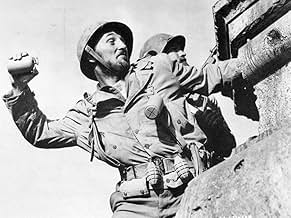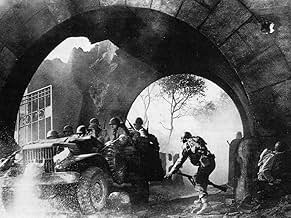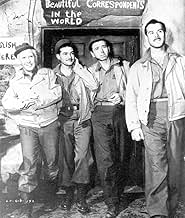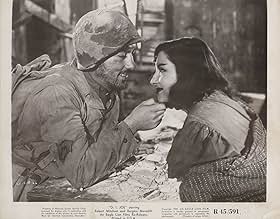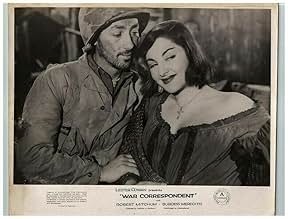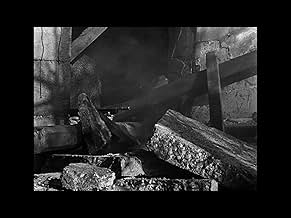IMDb RATING
7.2/10
4.1K
YOUR RATING
At the close of WWII, Pulitzer Prize-winning war correspondent Ernie Pyle travels with, and reports on, the U.S. Army's 77th Infantry Division during their liberation of Italy.At the close of WWII, Pulitzer Prize-winning war correspondent Ernie Pyle travels with, and reports on, the U.S. Army's 77th Infantry Division during their liberation of Italy.At the close of WWII, Pulitzer Prize-winning war correspondent Ernie Pyle travels with, and reports on, the U.S. Army's 77th Infantry Division during their liberation of Italy.
- Nominated for 4 Oscars
- 5 wins & 8 nominations total
John R. Reilly
- Private Murphy
- (as Jack Reilly)
William Murphy
- Private Mew
- (as Bill Murphy)
William 'Billy' Benedict
- Pvt. Whitey
- (uncredited)
Michael Browne
- Sergeant
- (uncredited)
Bob Hope
- Bob Hope (Voice on Radio Program)
- (voice)
- (uncredited)
Kenneth Kendall
- Extra
- (uncredited)
Yolanda Lacca
- Amelia, Italian Girl
- (uncredited)
Barney Noto
- Staff Sergeant Barney Noto
- (uncredited)
Tito Renaldo
- Lopez
- (uncredited)
Dick Rich
- Sergeant at Showers
- (uncredited)
William Self
- Pvt. Cookie Henderson
- (uncredited)
Featured reviews
The Story of G.I. Joe chronicles the experiences of an infantry unit in Italy as told by war correspondent Ernie Pyle, who is played by Burgess Meredith. War weary Robert Mitchum plays the platoon leader. While we can see that the movie was largely made in the studio, the great photography and direction move it along. Cold feet, mud, frustration, and homesickness are effectively demonstrated at the expense of battle scenes.
I entered for 17 weeks of infantry basic training at Camp Roberts California in January,1945. I was just 18. I was in the 96th, inf, training battlion. I am 73 now. The movie about Ernie Pyle was being made there in part. Some of the trainees were in the film. I recall my company marching over and over on this same hill to make it look like there was a full army there for the picture. My company commander was in the film as was the company mascot dog. I can't recall much more about the film as I have'nt seen it in a long time, getting old I guess. I surely would like to have a VCR copy of it too. If anyone has a copy to sell, please let me know. I recall that Burgess Meredith had lunch in the mess hall and shot the bull with the G.I.s there. Thats about all that I can remember for now. Hope this helps. G
One of the most fascinating tributes to the foot soldier is this 1945 war film that follows Ernie Pyle, beloved war correspondent, as he treks along through mud and ambushes with a platoon of weary G.I. Joes.
Robert Mitchum earned an Oscar nomination as Lt. Bill Walker and many of the other males in the cast were real combat soldiers who actually participated in the making of the film. The plot is no more than a series of skirmishes the platoon faces on a mission against Nazis in Italy. Burgess Meredith makes Ernie Pyle a likeable human being who wins the trust and affection of the platoon as he trudges with them across marshlands and all of the "up front" activity involved.
Human touches abound without the emphasis on cliches that often abound in war films. Mitchum gives just the right touch to his role as the leader who understands the strain his soldiers are under. The inclusion of a sub-plot involving a soldier anxious to hear the sound of his son's voice on a recording; and a pooch that becomes the mascot for the troops, are touches that give the film added humanity.
There is some editing that seems a bit jumpy in the latter part of the film, as though some cuts were made--but all in all this is a very watchable war film with a close-up look at the men and their courage under fire. A fine tribute also to Ernie Pyle, a famous Pulitzer Prize-winning war correspondent during the dark days of World War II. Highly recommended.
Robert Mitchum earned an Oscar nomination as Lt. Bill Walker and many of the other males in the cast were real combat soldiers who actually participated in the making of the film. The plot is no more than a series of skirmishes the platoon faces on a mission against Nazis in Italy. Burgess Meredith makes Ernie Pyle a likeable human being who wins the trust and affection of the platoon as he trudges with them across marshlands and all of the "up front" activity involved.
Human touches abound without the emphasis on cliches that often abound in war films. Mitchum gives just the right touch to his role as the leader who understands the strain his soldiers are under. The inclusion of a sub-plot involving a soldier anxious to hear the sound of his son's voice on a recording; and a pooch that becomes the mascot for the troops, are touches that give the film added humanity.
There is some editing that seems a bit jumpy in the latter part of the film, as though some cuts were made--but all in all this is a very watchable war film with a close-up look at the men and their courage under fire. A fine tribute also to Ernie Pyle, a famous Pulitzer Prize-winning war correspondent during the dark days of World War II. Highly recommended.
I found this to be a particularly poignant film about WWII - no heroics, just the simple getting through the day & night of a company of US infantry. Much like Ernie Pyle humanized the 'G. I.' in his written pieces, Wellman does the same on film. The heat, dirt, cold, mud, rain...fear, uncertainty, waste - it's all here without the bombast and manipulation of "Saving Private Ryan'. The performances are wonderful - most of the performances were given not by professionals but by the soldiers themselves. There is one scene between Mitchum and Meredith that was apparently an audition film - it was so right, it was simply inserted into the film. There are human touches throughout, as well as the insanity of war. I would strongly recommend this film to anyone who has an appreciation for the director, actors, theme. It's not a grisly film, and it is slow, but overall well worth watching.
The term "G.I. Joe" has become so closely associated with the image of a certain toy that it is now largely forgotten that it was originally coined to describe the ordinary American foot soldier. Likewise, it is now largely forgotten just exactly who Ernie Pyle was and what he meant to the American people and, more especially, to the ordinary soldiers about whom he wrote.
My father took a photograph of Ernie Pyle in the Pacific in 1945, shortly before Pyle was killed. At the time Pyle was surrounded by a mob of admiring G.Is. You'd have thought they were in the presence of Bettie Grable or Rita Hayworth rather than a short, balding, middle aged newspaper-man. When Pyle was killed in action a few days later while accompanying the infantry, the solders erected a monument at the place where he died. On it were engraved the words, "On this spot the 77th Division lost a buddy", and they really meant it. It's inconceivable that troops today would do anything like that for one of the current crop of CNN-generation reporters.
The reason isn't hard to fathom. Most war correspondents hung around the rear echelon, hobnobbing with the general staff and forwarding dispatches from headquarters, and they still do. Pyle, on the other hand, lived with and wrote about the common infantrymen who were actually fighting the war. He ate their food, drank their coffee and shared their hardships through three grueling years of war from North Africa through Sicily to the European mainland, and then later on in the Pacific, where he was killed. Pyle became the spokesman for the common soldiers, and all their families back home read his syndicated column. There simply wasn't anybody else like him then, and there hasn't been since.
Small wonder that William Wellman, himself a combat veteran, thought that this movie needed to be made. The filmmaker had tremendous respect for his subject, and it shows. For example, that poignant last scene is, almost word for word and image for image, straight out of one of Pyle's most famous dispatches. It would have been interesting to learn what Pyle thought of this film. Unfortunately, however, by the time it was released the Pulitzer Prize-winning reporter was already dead.
My father took a photograph of Ernie Pyle in the Pacific in 1945, shortly before Pyle was killed. At the time Pyle was surrounded by a mob of admiring G.Is. You'd have thought they were in the presence of Bettie Grable or Rita Hayworth rather than a short, balding, middle aged newspaper-man. When Pyle was killed in action a few days later while accompanying the infantry, the solders erected a monument at the place where he died. On it were engraved the words, "On this spot the 77th Division lost a buddy", and they really meant it. It's inconceivable that troops today would do anything like that for one of the current crop of CNN-generation reporters.
The reason isn't hard to fathom. Most war correspondents hung around the rear echelon, hobnobbing with the general staff and forwarding dispatches from headquarters, and they still do. Pyle, on the other hand, lived with and wrote about the common infantrymen who were actually fighting the war. He ate their food, drank their coffee and shared their hardships through three grueling years of war from North Africa through Sicily to the European mainland, and then later on in the Pacific, where he was killed. Pyle became the spokesman for the common soldiers, and all their families back home read his syndicated column. There simply wasn't anybody else like him then, and there hasn't been since.
Small wonder that William Wellman, himself a combat veteran, thought that this movie needed to be made. The filmmaker had tremendous respect for his subject, and it shows. For example, that poignant last scene is, almost word for word and image for image, straight out of one of Pyle's most famous dispatches. It would have been interesting to learn what Pyle thought of this film. Unfortunately, however, by the time it was released the Pulitzer Prize-winning reporter was already dead.
Did you know
- TriviaThe extras in the film were real American GIs, in the process of being transferred from the war in Europe to the Pacific. Many of them were killed in the fighting on Okinawa--the same battle in which Ernie Pyle was killed by a Japanese machine gunner--never having seen the movie in which they appeared.
- GoofsThe unit Pyle is with--the 18th Infantry Regiment, 1st Infantry Division--never fought in the Italian campaign. After the Sicilian campaign ended, it was brought back to England and began training for the D-Day invasion in Normandy. The 1st Division would eventually spearhead the assault on Omaha Beach.
- Quotes
Pvt. Dondaro: If this War don't kill me first, my feet will.
- Crazy creditsThere are absolutely no credits at the end of the film, not even the words "The End".
- ConnectionsEdited from La bataille de San Pietro (1945)
- SoundtracksSilent Night
(uncredited)
Music by Franz Xaver Gruber
Lyrics by Joseph Mohr
Sung by Elfie Mayerhofer on Decca Record
- How long is Story of G.I. Joe?Powered by Alexa
Details
- Release date
- Country of origin
- Languages
- Also known as
- También somos seres humanos
- Filming locations
- Iverson Ranch - 1 Iverson Lane, Chatsworth, Los Angeles, California, USA(marching through countryside just before the "baptism of fire.")
- Production company
- See more company credits at IMDbPro
Box office
- Budget
- $1,000,000 (estimated)
- Runtime
- 1h 48m(108 min)
- Color
- Aspect ratio
- 1.37 : 1
Contribute to this page
Suggest an edit or add missing content

